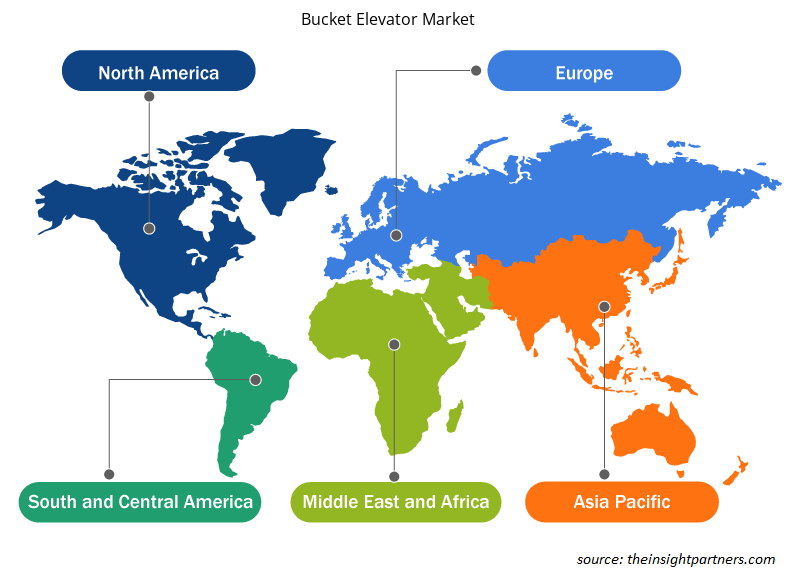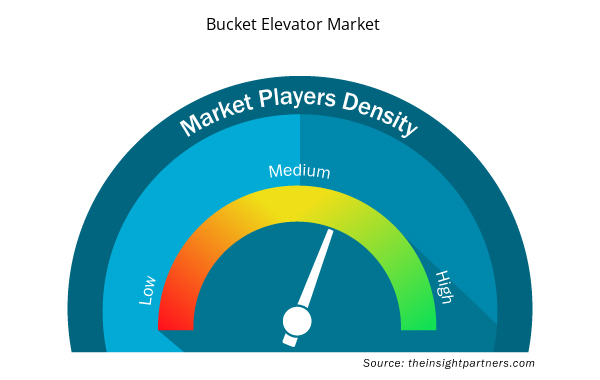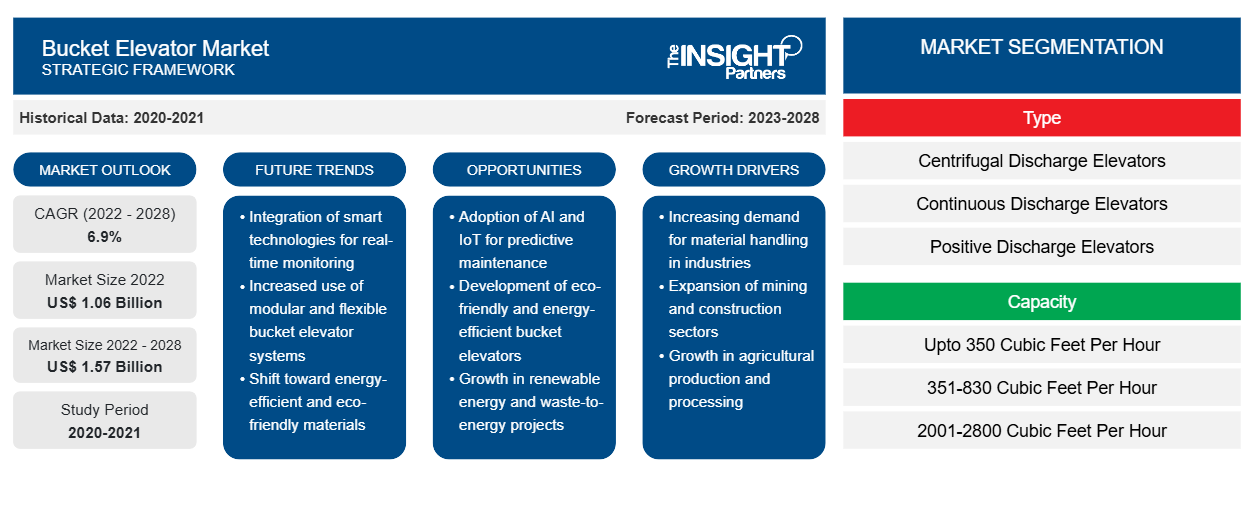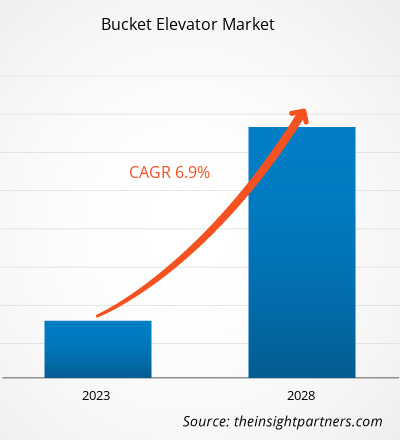Si prevede che il mercato degli elevatori a tazze raggiungerà 1.571,40 milioni di dollari entro il 2028, rispetto ai 1.055,12 milioni di dollari del 2022; si prevede che crescerà a un CAGR del 6,9% nel periodo 2022-2028.
Gli elevatori a tazze sono attrezzature efficienti dal punto di vista energetico e di spazio utilizzate per trasportare prodotti in grandi e piccole quantità. Sono disponibili in una varietà di tipi, design e stili per diverse applicazioni. Gli elevatori a tazze sono utilizzati principalmente per trasferire materiale dal livello del suolo a luoghi in quota. Sono costruiti con una cinghia di cotone o gomma che scorre su una puleggia motrice situata nella parte superiore, mentre l'altra estremità è la puleggia condotta che si trova nella parte inferiore all'interno di un involucro fabbricato. Gli elevatori a tazze centrifughi sono il tipo più comune di elevatori utilizzati in molti settori per trasportare verticalmente solidi sfusi in polvere, come cereali, zucchero, sabbia e minerali. Il loro utilizzo è comune nei settori del cemento, del vetro, minerario, della produzione di energia, della biomassa, della carta e delle costruzioni, nonché nei grandi frantoi e in altre industrie di trasformazione.
Personalizza questo report in base alle tue esigenze
Riceverai la personalizzazione gratuita di qualsiasi report, comprese parti di questo report, o analisi a livello nazionale, pacchetto dati Excel, oltre a usufruire di grandi offerte e sconti per start-up e università
- Scopri le principali tendenze di mercato in questo rapporto.Questo campione GRATUITO includerà analisi di dati che spaziano dalle tendenze di mercato alle stime e alle previsioni.
Impatto della pandemia di COVID-19 sulla crescita del mercato degli elevatori a tazze
La pandemia di COVID-19 ha avuto un impatto drammatico sull'economia mondiale durante il suo picco nel 2020. La crisi ha ostacolato le attività commerciali in vari settori. L'epidemia ha sconvolto diversi settori, come edilizia, alimentare, delle bevande, chimico e minerario. Poiché il lockdown ha prevalso nella maggior parte dei paesi, i progetti di costruzione sono stati temporaneamente interrotti, costringendo gli appaltatori a cambiare il loro modo di lavorare da un giorno all'altro. L'epidemia ha creato notevoli sconvolgimenti nel settore edile. Un forte calo del commercio internazionale ha avuto un impatto negativo sulla crescita dell'economia globale. Chiusure di fabbriche e produzione, divieti commerciali, interruzioni delle catene di fornitura e delle attività di gestione degli acquisti, scarsità di manodopera e restrizioni alla circolazione transfrontaliera per combattere la diffusione della malattia hanno avuto un impatto negativo sul lavoro delle aziende in tutto il mondo. L'impatto negativo della pandemia su diversi settori ha limitato la crescita del mercato degli elevatori a tazze . Tuttavia, i settori hanno mostrato una crescita significativa con facilità nelle restrizioni e la riapertura delle fabbriche nel 2021. Ora si stanno concentrando sempre di più sul miglioramento della larghezza di banda, della compatibilità e dell'efficienza attraverso l'adozione e gli investimenti tecnologici. Nonostante l'impatto negativo della pandemia di COVID-19 nel 2020, il mercato globale degli elevatori a tazze ha registrato una forte ripresa.
Approfondimenti di mercato – Mercato degli elevatori a tazze
L'aumento dei lavori di costruzione nei settori residenziale, commerciale e altri ha stimolato la crescita dell'industria del cemento. Gli enti governativi stanno sempre più sottolineando il supporto allo sviluppo edilizio e infrastrutturale. I produttori di cemento sono tra i maggiori clienti dei player del mercato degli elevatori a tazze. Hanno aggiornato i loro impianti per far fronte all'aumento della domanda di cemento, che ha stimolato l'installazione di elevatori a tazze. Nell'ottobre 2022, MDG America è stata selezionata per fornire allo stabilimento di Drake Cement situato a Paulden, Arizona, Stati Uniti, quattro elevatori a tazze a catena di alta qualità. Nel marzo 2021, UltraTech Cement Limited ha scelto AUMUND India per fornire un pacchetto completo di attrezzature che includeva 46 elevatori a tazze a nastro. Il contratto includeva la fornitura di elevatori a tazze di alimentazione forno critici con altezze fino a 157 m, elevatori a tazze per la movimentazione di materie prime, elevatori a tazze per la movimentazione di clinker e cemento (varie dimensioni) ed elevatori a tazze a ricircolo con presse a rulli con capacità fino a 2.200 tonnellate all'ora (tph). Pertanto, la crescente adozione degli elevatori a tazze nell'industria del cemento stimola la crescita del mercato degli elevatori a tazze.
Informazioni basate sul tipo
Il tipo di elevatore a tazze scelto dipende dall'applicazione a cui è destinato. Viene anche scelto per supportare il flusso di processo più efficiente. Il mercato degli elevatori a tazze, per tipo, è segmentato in elevatori a scarico centrifugo, elevatori a scarico continuo ed elevatori a scarico positivo. Il segmento degli elevatori a scarico centrifugo ha rappresentato la quota di mercato maggiore nel 2021. Si prevede inoltre che registrerà il CAGR più rapido durante il periodo di previsione.
Il mercato degli elevatori a tazze è segmentato in base a tipo, capacità, settore e geografia. In base al tipo, il mercato è segmentato in elevatori a scarico centrifugo, elevatori a scarico continuo ed elevatori a scarico positivo. In base alla capacità, il mercato degli elevatori a tazze è suddiviso in 350-830 piedi cubi all'ora, 2001-2800 piedi cubi all'ora, 831-2000 piedi cubi all'ora, oltre 2801 piedi cubi all'ora e sotto 350 piedi cubi all'ora. In base al settore, il mercato è segmentato in edilizia, agricoltura, estrazione mineraria, alimentare, energia e servizi di pubblica utilità, carta e cellulosa e altri. In termini di geografia, il mercato degli elevatori a tazze è segmentato in cinque regioni principali: Nord America, Europa, Asia Pacifico (APAC), Medio Oriente e Africa (MEA) e Sud America (SAM). Tra i principali attori del mercato degli elevatori a tazze figurano BEUMER Group GmbH & Co KG, FEECO International Inc, Gough & Co (Engineering) Ltd, KWS Manufacturing Co Ltd, Motridal SpA, Skandia Elevator AB, Sukup Manufacturing Co, Satake Corp, Ryson International Inc e AGCO Corp.
Approfondimenti regionali sul mercato degli elevatori a tazze
Le tendenze regionali e i fattori che influenzano il mercato degli elevatori a tazze durante il periodo di previsione sono stati ampiamente spiegati dagli analisti di Insight Partners. Questa sezione discute anche i segmenti e la geografia del mercato degli elevatori a tazze in Nord America, Europa, Asia Pacifico, Medio Oriente e Africa e Sud e Centro America.

- Ottieni i dati specifici regionali per il mercato degli elevatori a tazze
Ambito del rapporto di mercato degli elevatori a tazze
| Attributo del report | Dettagli |
|---|---|
| Dimensioni del mercato nel 2022 | 1,06 miliardi di dollari USA |
| Dimensioni del mercato entro il 2028 | 1,57 miliardi di dollari USA |
| CAGR globale (2022 - 2028) | 6,9% |
| Dati storici | 2020-2021 |
| Periodo di previsione | 2023-2028 |
| Segmenti coperti | Per tipo
|
| Regioni e Paesi coperti | America del Nord
|
| Leader di mercato e profili aziendali chiave |
|
Densità degli attori del mercato: comprendere il suo impatto sulle dinamiche aziendali
Il mercato degli elevatori a tazze sta crescendo rapidamente, spinto dalla crescente domanda degli utenti finali dovuta a fattori quali l'evoluzione delle preferenze dei consumatori, i progressi tecnologici e una maggiore consapevolezza dei vantaggi del prodotto. Con l'aumento della domanda, le aziende stanno ampliando le loro offerte, innovando per soddisfare le esigenze dei consumatori e capitalizzando sulle tendenze emergenti, il che alimenta ulteriormente la crescita del mercato.
La densità degli operatori di mercato si riferisce alla distribuzione di aziende o società che operano in un particolare mercato o settore. Indica quanti concorrenti (operatori di mercato) sono presenti in un dato spazio di mercato in relazione alle sue dimensioni o al valore di mercato totale.
Le principali aziende che operano nel mercato degli elevatori a tazze sono:
- Gruppo BEUMER GmbH & Co KG
- FEECO International Inc
- Gough & Co (Ingegneria) Ltd
- Società di produzione KWS Ltd.
- Motridal SpA
Disclaimer : le aziende elencate sopra non sono classificate secondo un ordine particolare.

- Ottieni una panoramica dei principali attori del mercato degli elevatori a tazze
Gli operatori del mercato degli elevatori a tazze si concentrano principalmente sul lancio di prodotti e sulle partnership per creare valore per il cliente.
- A dicembre 2022, Ryson International, Inc., ha lanciato una nuova gamma di elevatori per rinfuse, progettati per trasportare una varietà di materiali sfusi. I nuovi elevatori per rinfuse di Ryson combinano il trasporto verticale e orizzontale. Gli elevatori chiusi presentavano tazze pivotanti sovrapposte per aiutare a prevenire la fuoriuscita di prodotto e mitigare i detriti estranei.
- Nel settembre 2022, Muller Beltex BV, VAV Aandrijvingen BV e Bechtel GmbH hanno annunciato un'alleanza strategica per posizionarsi meglio sul mercato e fornire ai propri clienti materiali, conoscenze e servizi in modo migliore e più efficiente.
- Analisi storica (2 anni), anno base, previsione (7 anni) con CAGR
- Analisi PEST e SWOT
- Valore/volume delle dimensioni del mercato - Globale, regionale, nazionale
- Industria e panorama competitivo
- Set di dati Excel


- Fish Protein Hydrolysate Market
- Automotive Fabric Market
- Emergency Department Information System (EDIS) Market
- Sterilization Services Market
- Authentication and Brand Protection Market
- Blood Collection Devices Market
- Lymphedema Treatment Market
- Antibiotics Market
- Webbing Market
- Influenza Vaccines Market

Report Coverage
Revenue forecast, Company Analysis, Industry landscape, Growth factors, and Trends

Segment Covered
This text is related
to segments covered.

Regional Scope
North America, Europe, Asia Pacific, Middle East & Africa, South & Central America

Country Scope
This text is related
to country scope.
Domande frequenti
BEUMER Group GmbH & Co KG, FEECO International Inc, Gough & Co (Engineering) Ltd, KWS Manufacturing Co Ltd, Motridal SpA, Skandia Elevator AB, Sukup Manufacturing Co, Satake Corp, Ryson International Inc, and AGCO Corp are the leading companies in the bucket elevators market.
Integration of predictive maintenance solutions is one of the major trends in the bucket elevators market.
North America dominated the bucket elevators market in 2021. In the past decade, logistics in North America have seen tremendous growth, owing to factors such favorable measures by governments, and investments by public and private authorities promote the growth of different industries in the region. Cement manufacturers, fertilizer manufacturers, grain processing plants, and mining sites are a few of the major end users of bucket elevators in North American countries. A rise in construction activities across these countries is a key contributor to the demand for bucket elevators, as these systems are used in the vertical transportation of sand, cement, and bricks in the construction industry.
Growth in infrastructure projects promoting application of bucket elevators in cement plants augments the growth of the bucket elevators market.
Growing demand of food grains and seeds is creating growth opportunity for the market players operating into the market.
Trends and growth analysis reports related to Electronics and Semiconductor : READ MORE..
The List of Companies - Bucket Elevator Market
- BEUMER Group GmbH & Co KG
- FEECO International Inc
- Gough & Co (Engineering) Ltd
- KWS Manufacturing Co Ltd
- Motridal SpA
- Skandia Elevator AB
- Sukup Manufacturing Co
- Satake Corp
- Ryson International Inc
- AGCO Corp
The Insight Partners performs research in 4 major stages: Data Collection & Secondary Research, Primary Research, Data Analysis and Data Triangulation & Final Review.
- Data Collection and Secondary Research:
As a market research and consulting firm operating from a decade, we have published and advised several client across the globe. First step for any study will start with an assessment of currently available data and insights from existing reports. Further, historical and current market information is collected from Investor Presentations, Annual Reports, SEC Filings, etc., and other information related to company’s performance and market positioning are gathered from Paid Databases (Factiva, Hoovers, and Reuters) and various other publications available in public domain.
Several associations trade associates, technical forums, institutes, societies and organization are accessed to gain technical as well as market related insights through their publications such as research papers, blogs and press releases related to the studies are referred to get cues about the market. Further, white papers, journals, magazines, and other news articles published in last 3 years are scrutinized and analyzed to understand the current market trends.
- Primary Research:
The primarily interview analysis comprise of data obtained from industry participants interview and answers to survey questions gathered by in-house primary team.
For primary research, interviews are conducted with industry experts/CEOs/Marketing Managers/VPs/Subject Matter Experts from both demand and supply side to get a 360-degree view of the market. The primary team conducts several interviews based on the complexity of the markets to understand the various market trends and dynamics which makes research more credible and precise.
A typical research interview fulfils the following functions:
- Provides first-hand information on the market size, market trends, growth trends, competitive landscape, and outlook
- Validates and strengthens in-house secondary research findings
- Develops the analysis team’s expertise and market understanding
Primary research involves email interactions and telephone interviews for each market, category, segment, and sub-segment across geographies. The participants who typically take part in such a process include, but are not limited to:
- Industry participants: VPs, business development managers, market intelligence managers and national sales managers
- Outside experts: Valuation experts, research analysts and key opinion leaders specializing in the electronics and semiconductor industry.
Below is the breakup of our primary respondents by company, designation, and region:

Once we receive the confirmation from primary research sources or primary respondents, we finalize the base year market estimation and forecast the data as per the macroeconomic and microeconomic factors assessed during data collection.
- Data Analysis:
Once data is validated through both secondary as well as primary respondents, we finalize the market estimations by hypothesis formulation and factor analysis at regional and country level.
- Macro-Economic Factor Analysis:
We analyse macroeconomic indicators such the gross domestic product (GDP), increase in the demand for goods and services across industries, technological advancement, regional economic growth, governmental policies, the influence of COVID-19, PEST analysis, and other aspects. This analysis aids in setting benchmarks for various nations/regions and approximating market splits. Additionally, the general trend of the aforementioned components aid in determining the market's development possibilities.
- Country Level Data:
Various factors that are especially aligned to the country are taken into account to determine the market size for a certain area and country, including the presence of vendors, such as headquarters and offices, the country's GDP, demand patterns, and industry growth. To comprehend the market dynamics for the nation, a number of growth variables, inhibitors, application areas, and current market trends are researched. The aforementioned elements aid in determining the country's overall market's growth potential.
- Company Profile:
The “Table of Contents” is formulated by listing and analyzing more than 25 - 30 companies operating in the market ecosystem across geographies. However, we profile only 10 companies as a standard practice in our syndicate reports. These 10 companies comprise leading, emerging, and regional players. Nonetheless, our analysis is not restricted to the 10 listed companies, we also analyze other companies present in the market to develop a holistic view and understand the prevailing trends. The “Company Profiles” section in the report covers key facts, business description, products & services, financial information, SWOT analysis, and key developments. The financial information presented is extracted from the annual reports and official documents of the publicly listed companies. Upon collecting the information for the sections of respective companies, we verify them via various primary sources and then compile the data in respective company profiles. The company level information helps us in deriving the base number as well as in forecasting the market size.
- Developing Base Number:
Aggregation of sales statistics (2020-2022) and macro-economic factor, and other secondary and primary research insights are utilized to arrive at base number and related market shares for 2022. The data gaps are identified in this step and relevant market data is analyzed, collected from paid primary interviews or databases. On finalizing the base year market size, forecasts are developed on the basis of macro-economic, industry and market growth factors and company level analysis.
- Data Triangulation and Final Review:
The market findings and base year market size calculations are validated from supply as well as demand side. Demand side validations are based on macro-economic factor analysis and benchmarks for respective regions and countries. In case of supply side validations, revenues of major companies are estimated (in case not available) based on industry benchmark, approximate number of employees, product portfolio, and primary interviews revenues are gathered. Further revenue from target product/service segment is assessed to avoid overshooting of market statistics. In case of heavy deviations between supply and demand side values, all thes steps are repeated to achieve synchronization.
We follow an iterative model, wherein we share our research findings with Subject Matter Experts (SME’s) and Key Opinion Leaders (KOLs) until consensus view of the market is not formulated – this model negates any drastic deviation in the opinions of experts. Only validated and universally acceptable research findings are quoted in our reports.
We have important check points that we use to validate our research findings – which we call – data triangulation, where we validate the information, we generate from secondary sources with primary interviews and then we re-validate with our internal data bases and Subject matter experts. This comprehensive model enables us to deliver high quality, reliable data in shortest possible time.


 Ottieni un campione gratuito per questo repot
Ottieni un campione gratuito per questo repot